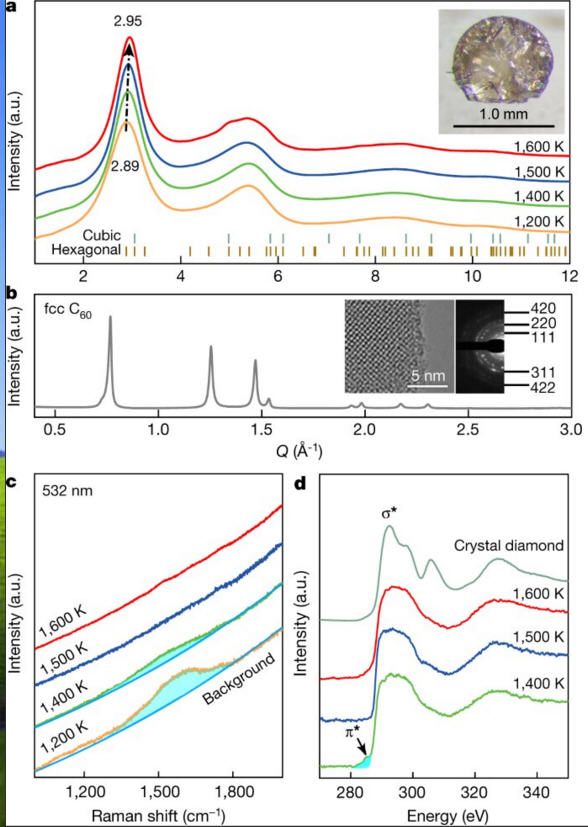博文
Nature: 中德美科学家用富勒烯制造不那么脆的金刚石
 精选
精选
||
Nature: 中德美科学家用富勒烯制造不那么脆的金刚石
诸平

Fig. 1: Synthesizing fully sp3-bonded carbon samples at 30 GPa and 1,200–1,600 K for 10 min. Credit: DOI: 10.1038/s41586-021-04122-w

据物理学家组织网(Phys.org)2021年11月28日报道,来自中国、德国和美国的科学家组成的一个研究小组,开发了一种制造不那么脆的金刚石的方法(Creating a less fragile diamond using fullerenes)。相关研究结果于2021年11月24日已经在《自然》(Nature)杂志网站发表——Hu Tang, Xiaohong Yuan, Yong Cheng, Hongzhan Fei, Fuyang Liu, Tao Liang, Zhidan Zeng, Takayuki Ishii, Ming-Sheng Wang, Tomoo Katsura, Howard Sheng, Huiyang Gou. Synthesis of paracrystalline diamond. Nature, 2021, 599: 605–610. DOI: 10.1038/s41586-021-04122-w. Published: 24 November 2021. http://dx.doi.org/10.1038/s41586-021-04122-w.在该论文中,研究小组描述了他们制造准晶金刚石(paracrystalline diamond)的方法及其可能的用途。参与此项研究的有来自中国高压科技前沿研究中心(Center for High Pressure Science and Technology Advanced Research, Beijing, China)、厦门大学材料学院(College of Materials, Xiamen University, Xiamen, China)、燕山大学环境与化工学院(College of Environmental and Chemical Engineering, Yanshan University, Qinhuangdao, China)德国拜罗伊特大学(University of Bayreuth, Germany)以及美国乔治·梅森大学(George Mason University, Fairfax, VA, USA)的研究人员。
先前的研究表明,金刚石是已知的最坚硬的材料,但它也很脆,尽管它们很硬,金刚石很容易被切割甚至破碎,这是因为它们有序的原子结构所致。多年来,科学家们一直试图合成出既保持硬度又不那么脆的金刚石。该团队的研究结果现在已经接近实现这一目标。
目前,制造金刚石(diamonds)的方法是将一种碳基材料置于一个类似牢固的装置中,将其加热到非常高的温度,同时需要高压。在这项新的研究中,研究人员用同样的方法创造了一种秩序不那么有序的金刚石,但增加了一种新的扭曲,碳基材料是一批富勒烯(fullerenes),也被称为巴克球(buckyballs),即碳原子排列成的空心球状体。他们将这种材料加热到900-1300 ℃,压力为27-30吉帕(gigapascals简称GPa)。值得注意的是,施加的压力远低于用于制造商业金刚石的压力。在加工过程中,这些球体被迫坍塌,并形成透明的准晶金刚石(transparent paracrystalline diamonds),可以在室温下提取。上述图2左边的是单晶金刚石(crystalline diamond)和右边的次晶金刚石(paracrystalline diamond) 的结构比较。在右边的以蓝绿色标记的立方碳原子单位,以黄色标记六角形碳原子单位,不规则的结构则用红色标出。
在制造出顺序较差的金刚石后,研究人员在电子显微镜(electron microscope)下观察它们,以进一步了解它们的结构。他们还对样品进行了x射线衍射和原子建模(atomist modeling)。在这样做的过程中,他们发现他们的金刚石正如他们所预期的那样,是由无序的sp3杂化碳组成的。创造不那么脆的金刚石的目标已经实现。与最近另一项合成不那么脆的金刚石的研究结果不同,他们合成的金刚石不是完全无定形的(这使其成为一种玻璃型的),他们的结果是一种无定形金刚石的不完全晶体(amorphous diamond paracrystal)。这意味着它有一个中等距离的顺序,它的原子在短距离上是有序的(short distances),而不是在长距离上。因此,不存在原子平面,这意味着此种金刚石不能像天然钻石那样被切割。
上述介绍,仅供参考。欲了解更多信息,敬请注意浏览原文或者相关报道。
Solids in nature can be generally classified into crystalline and non-crystalline states1,2,3,4,5,6,7, depending on whether long-range lattice periodicity is present in the material. The differentiation of the two states, however, could face fundamental challenges if the degree of long-range order in crystals is significantly reduced. Here we report a paracrystalline state of diamond that is distinct from either crystalline or amorphous diamond8,9,10. The paracrystalline diamond reported in this work, consisting of sub-nanometre-sized paracrystallites that possess a well-defined crystalline medium-range order up to a few atomic shells4,5,11,12,13, was synthesized in high-pressure high-temperature conditions (for example, 30 GPa and 1,600 K) employing face-centred cubic C60 as a precursor. The structural characteristics of the paracrystalline diamond were identified through a combination of X-ray diffraction, high-resolution transmission microscopy and advanced molecular dynamics simulation. The formation of paracrystalline diamond is a result of densely distributed nucleation sites developed in compressed C60 as well as pronounced second-nearest-neighbour short-range order in amorphous diamond due to strong sp3 bonding. The discovery of paracrystalline diamond adds an unusual diamond form to the enriched carbon family14,15,16, which exhibits distinguishing physical properties and can be furthered exploited to develop new materials. Furthermore, this work reveals the missing link in the length scale between amorphous and crystalline states across the structural landscape, having profound implications for recognizing complex structures arising from amorphous materials.
https://blog.sciencenet.cn/blog-212210-1314409.html
上一篇:Science: 利用分子和原子进行双缝实验
下一篇:研究表明,相信占星术的人往往不太聪明,而且更自恋